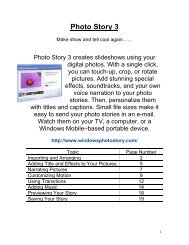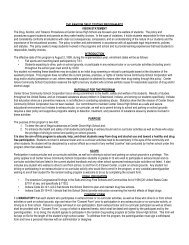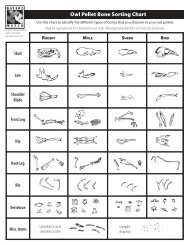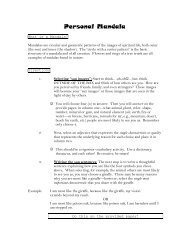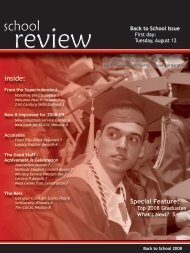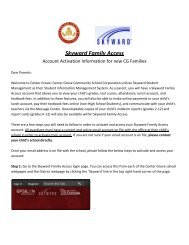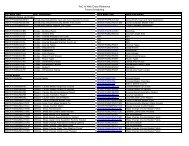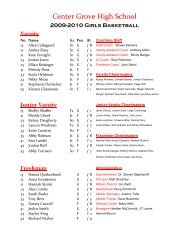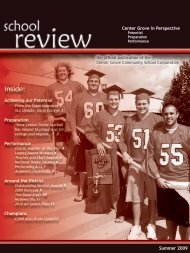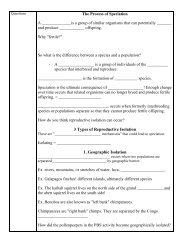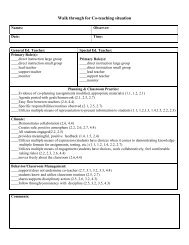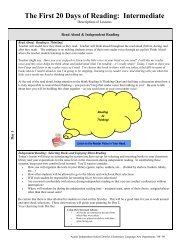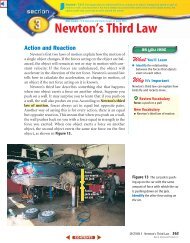Fall/Winter 2008-09 Issue - Center Grove Community School ...
Fall/Winter 2008-09 Issue - Center Grove Community School ...
Fall/Winter 2008-09 Issue - Center Grove Community School ...
Create successful ePaper yourself
Turn your PDF publications into a flip-book with our unique Google optimized e-Paper software.
long-range facilities plan<br />
the new 3 r’s<br />
We adopted the “New 3 R’s” terminology<br />
from the 2005 Bill Gates speech to the National<br />
Governors’ Association entitled, “America’s<br />
High <strong>School</strong>s are Obsolete.”<br />
“High Tech High’s scores on statewide<br />
academic tests are 15 percent higher than the<br />
rest of the district; their SAT scores are an<br />
average of 139 points higher.<br />
These are the kind of results you can get<br />
when you design a high school to prepare every<br />
student for college.<br />
These are not isolated examples. These<br />
are schools built on principles that can be<br />
applied anywhere – the new three R’s, the basic<br />
building blocks of better high schools:<br />
The first R is Rigor – making sure all<br />
students are given a challenging curriculum<br />
that prepares them for college or work;<br />
The second R is Relevance – making sure<br />
kids have courses and projects that clearly<br />
relate to their lives and their goals;<br />
The third R is Relationships – making sure<br />
kids have a number of adults who know them,<br />
look out for them, and push them to achieve.”<br />
We work with those definitions, but after<br />
additional contemplation, research, and<br />
applying the concepts to <strong>Center</strong> <strong>Grove</strong>, we<br />
changed the order to relationships, relevance,<br />
and rigor.<br />
Willard Daggett, Ph.D., founder and<br />
President of the International <strong>Center</strong> for<br />
Keystone is a class that all freshmen take during their first semester.<br />
The class is an orientation to high school, and develops study skills,<br />
career interests, and college readiness. Career interests are identified<br />
through career inventories, career clusters, and job shadowing. The<br />
students also learn about college requirements for their potential career<br />
choices.<br />
The final exam for Keystone has been<br />
to create a portfolio which included their<br />
high school career major (one of eight),<br />
essay, a Power Point presentation of their<br />
job shadowing experience, and other<br />
information. The portfolio was placed in<br />
a binder and later provided to their STaR<br />
teachers.<br />
This semester, the class is utilizing<br />
the Epsilen Environment, the on-line<br />
professional networking environment<br />
which each CG middle and high school<br />
student may access through a personal<br />
account. The final exams will now be to create an electronic portfolio<br />
which can follow the students throughout their high school careers and<br />
beyond.<br />
and how they will be incorporated into the proposed High <strong>School</strong> Redesign.<br />
Leadership in Education, said that the<br />
point about relationships is that learning is<br />
personal. When students have strong, trusting<br />
relationships with their teachers, they work<br />
harder and achieve more. It’s so common and<br />
so easy to get excited about the rigor (this could<br />
be technology, new classroom pedagogy, etc.)<br />
that we forget to build strong foundational<br />
relationships before setting off on our journey.<br />
Once the relationships are established, we<br />
can move to relevance. The more students<br />
understand how what they are learning is<br />
relevant to them, to their community, or to the<br />
world at large; the more motivated they will be<br />
to learn.<br />
next issue:<br />
smaller learning communities<br />
Paul Buck, Assistant Principal at <strong>Center</strong> <strong>Grove</strong> High <strong>School</strong> and leader of the High <strong>School</strong> Redesign Team, talks about the New Three R’s,<br />
As leaders it is important to create change<br />
narratives that address relevance. The most<br />
powerful narratives address relevance in two<br />
ways: 1) How is this new action or way of doing<br />
things going to affect YOU, as an individual?<br />
and 2) How is this new action or way of<br />
doing things going to affect the world outside<br />
yourself?<br />
Leaders who can create narratives that<br />
express the ways change will take care of the<br />
stakeholder’s personal concerns, and at the<br />
same time explain how the change will be<br />
making the classroom, school, or world a better<br />
place; have set the scene for great things to<br />
happen.<br />
Relationships and relevance make rigor<br />
possible.<br />
When the decision was made by the<br />
community to maintain one high school for<br />
the district, it came with a mandate to keep the<br />
school personal, and as enrollment continues<br />
to grow to make it “feel” smaller. In the next<br />
issue, we’ll address the role smaller learning<br />
communities will play. They affect this<br />
element of the equation, however, in creating<br />
an environment for student-teacher and peer<br />
relationships to develop and thrive. Another<br />
excerpt from the Bill Gates speech:<br />
“The three R’s are almost always easier to<br />
promote in smaller high schools. The smaller<br />
size gives teachers and staff the chance to<br />
“The New 3 R’s” continued on page 7<br />
Relationships: Electronic Portfolios<br />
Tracy Buck, CGHS Lead Teacher for Keystone: Orientation to Life and Careers, talks about the new electronic portfolios<br />
being created by freshmen in the class of 2012.<br />
The e-portfolios will include a resume, showcase (work they’ve<br />
done, presentations, essays, art work, video projects, audio files, and<br />
more), interest inventories (value survey, learning style, personality<br />
traits correlated to types of jobs), post secondary education plan, and<br />
career and college resources. The menu is customizable, so students<br />
may also include additional information such as<br />
transcripts and test scores. They may also apply<br />
access codes for information that is private.<br />
When these students are assigned to their<br />
STaR or future advisory classes, their teachers<br />
can simply access their e-portfolios on-line,<br />
and learn all about the aptitude and interests of<br />
the students. This allows the relationship piece<br />
to begin before the students ever arrive in the<br />
classroom!<br />
“Everything they do here is preparation for<br />
the college classroom,” said Mrs. Buck. “And the<br />
kids love it! They come in and ask every day, ‘Are<br />
we going to the computer lab?’”<br />
When they begin to apply for college, scholarships, or the job market,<br />
they can simply include a link or URL in their applications and their<br />
e-portfolios will be available for viewing.<br />
Page 3 <strong>Fall</strong>/<strong>Winter</strong> <strong>2008</strong>-<strong>09</strong>



